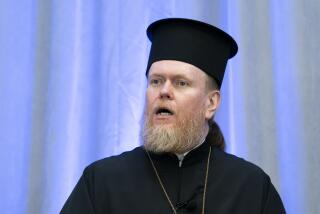Churches Crowded but ‘Too Few’ Priests : Catholic Church Demonstrates Durability in Soviet Lithuania
- Share via
KAUNAS, Soviet Union — The Roman Catholic Church in Lithuania, under pressure from atheist Soviet officials for nearly half a century, shows remarkable powers of survival.
A random check on a recent weekend found overflow crowds at Sunday services. On weekdays, there is a steady stream of worshipers as well.
In contrast to the older women who make up the greater part of congregations in Russian Orthodox churches in the Soviet Union, Lithuanian churchgoers include children and young people, and almost as many men as women.
Constant Struggle
Still, Catholic clergymen say, it is a constant struggle to observe the faith in a country where Sunday schools are against the law and the government strictly controls the number of priests.
In Kaunas, the site of Lithuania’s only seminary for training priests, 130 young men are enrolled. They are needed to replace some of the 800 active priests, whose average age is said to be 65. There are “few--too few--priests,” a senior Catholic cleric said in a recent interview.
In 1940, before the Soviet annexation of Lithuania, there were 1,451 priests here.
At the 15th-Century St. Anne’s Church in Vilnius, the Lithuanian capital, the elderly, slow-moving priest who celebrated Mass had to be helped into a chair by two aides. Another, slightly younger, priest administered Communion.
Many Parishes in Lithuania
There are still 630 Catholic parishes in Lithuania, contrasted with 1,202 before the Soviet takeover, but the 103 monasteries and convents in existence at that time were closed after World War II.
But in Lithuania, Catholicism has strong roots, dating back to the 14th Century. It is intertwined with nationalist sentiments that surfaced in a public demonstration Aug. 23, a first for this tightly controlled republic.
Religious songs and patriotic anthems from pre-Soviet times were sung by several hundred people gathered near St. Anne’s. Niyole Sadonaite, one of the speakers, had spent three years in a prison camp and three more in exile for helping to publish the underground “Chronicle of the Catholic Church in Lithuania” in the 1970s.
There are no statistics on the number of Catholics who attend church regularly in Lithuania, where 90% of the population live in traditionally Catholic communities.
Confidential Matter
“The number of believers in the republic . . . is unknown since in conformity with the guarantees of freedom of conscience, no official form or paper . . . requires a person to state his or her religious beliefs,” according to a 1987 booklet on Lithuania issued by the Novosti publishing house in Moscow.
But an encyclopedia printed a year earlier in Lithuania contradicts this assertion:
“At present, the majority of the population of the Lithuanian (republic) are non-believers,” the encyclopedia says. “Secularization and atheism have become increasingly stronger.”
To reduce Catholic loyalties, a clergyman said, the Soviet authorities have curtailed the number of new priests, forbidden them to teach children about religion and carried out an active propaganda campaign against the church.
Vatican Agrees
The Vatican, too, says that the Lithuanian government has at times impeded the work of clergymen. Pope John Paul II, a native of neighboring Poland, has secretly picked a cardinal for Lithuania but keeps the man’s identity secret for fear that disclosure would subject him to persecution.
A papal visit to Lithuania has been proposed repeatedly, but church officials here believe that the Kremlin has vetoed the idea in order to discourage renewed interest in religion.
“Of course, everyone wants the Pope to come, but it won’t happen,” a clergyman said. “Moscow doesn’t want it, and you know what that means.”
The state has underlined its antagonism toward religion in other ways as well. St. Casimir’s Church in Vilnius, for example, has been turned into a museum to promote atheism. Vilnius Cathedral was taken over by the government in 1953 and is now used as a concert hall and museum.
Church Disparaged
The church and clergymen have been disparaged in Soviet publications and depicted as collaborators with the Nazi occupation during World War II.
Advocates of Lithuanian independence have made an issue of religious discrimination, and the church became a natural ally for advocates of national autonomy.
“As in Poland, religious strength had come to be equated with national identity,” Romuald J. Misiunas and Rein Taagepera said in their 1980 book “The Baltic States: Years of Dependence.”
But the state is equally stubborn in its opposition.
“People are free to go to church, but it’s not encouraged, and the state makes very active propaganda against it,” a resident of Vilnius said.
A Lithuanian clergyman, who said he is a realist, described the situation this way: “I have lived through the Nazi occupation and the early postwar years under Stalin, and of course conditions are better than that.”
More to Read
Sign up for Essential California
The most important California stories and recommendations in your inbox every morning.
You may occasionally receive promotional content from the Los Angeles Times.













